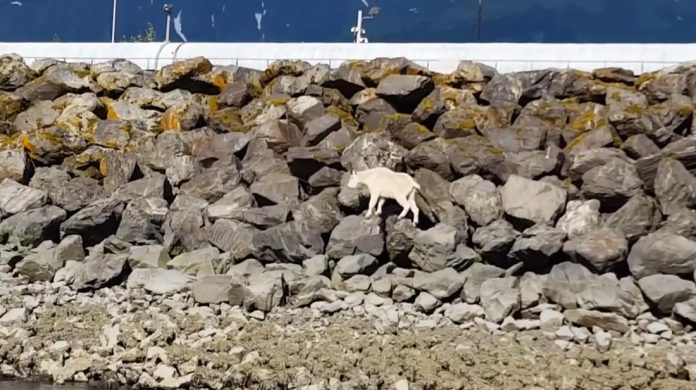
[Video below] — It was a sight that would give even seasoned Alaskans pause – a mountain goat trotting along the harbor in the city of Seward. For the expanse of Alaskan coast on which it perches, Seward may well be a bustling metropolis. It is an active fishing hub, the starting point of the historic Iditarod trail and a destination that draws tourists who have wandered south from Anchorage.
The city has been visited by moose, porcupines and the odd bear. Mountain goats, however, are not regular guests in Seward.
The animal, the crisp white of its coat broken only by black features, would have been more at home in steeper, remote climes. Instead, it somehow found its way to the dike at Seward’s Resurrection Bay on Saturday. A portentous name, perhaps – and an unfortunate one for the goat. This trip would have no return.
Around 6:30 p.m., Alaska State Troopers caught wind of the goat’s journey. It was being harassed by a group of people who wanted to photograph it, the officers said in a news dispatch.
But when the troopers arrived, the goat had vanished.
Kerri O’Neill, in Seward for dinner with her daughter, spotted the animal scampering through a restaurant’s parking lot and then onto the beach. It seemed to be trying to find its way back into the wilderness, she told Alaska’s KTUU. But it had drawn a gawking crowd, with some snapping photographs. With nowhere left to turn, the goat dove into the ocean.
“Investigation revealed a large amount of people followed the goat towards the SeaLife Center on the rocks,” the Alaska State Troopers wrote, “resulting in the goat jumping back into the water.”
Even in the water it was not alone. “There was a sea otter next to it,” O’Neill told KTUU. “And then a woman’s spaniel swam out to it.” She said she called the Alaska SeaLife Center, which forwarded her to the Alaska Wildlife Conservation Center, who told her to tell onlookers to stand back.
About 30 minutes elapsed between the time the troopers searched the dike for the goat and the goat’s seaward plunge. It had exhausted all of its options – the beach was now covered in onlookers. Cornered in the water, the goat drowned. The troopers declared the animal had died “for no cause.” Or, at least, needlessly frivolous ones: People did not give the animal space, the authorities said, and came too close to take photos.
Mountain goats have been spotted swimming before, though their cloven hooves are better adapted for balancing on steep inclines. They are rarely seen below the timberline. The Alaska Department of Fish and Game calls the species among the “least-studied large mammals in North America.” Despite the name, mountain goats are more closely related to antelope than domesticated goats.
A passing boat, the Interceptor, recovered the goat’s carcass. Its body, the police said, was donated.
This is the most recent in a string of wild animal encounters that ended poorly for the critter. In Washington state, a woman mistakenly believed she was rescuing a baby harbor seal, carrying the animal home in a shopping bag. Wildlife officials who took the seal found it too lethargic to live, euthanizing the animal in early July.
At Yellowstone National Park in May, a pair of tourists spied a young bison, which they thought looked cold and so placed in the back of their car. Rangers later killed the calf because it could not be returned to the wild. Earlier still in the year, Argentinian beach-goers held a baby dolphin out of the water to take photos, only to leave it on the sand to die.
(c) 2016, The Washington Post · Ben Guarino

